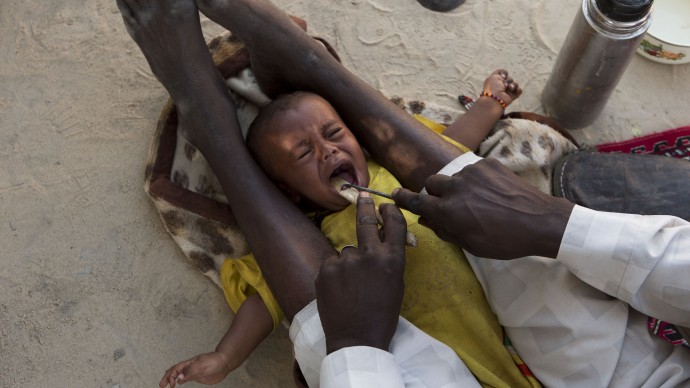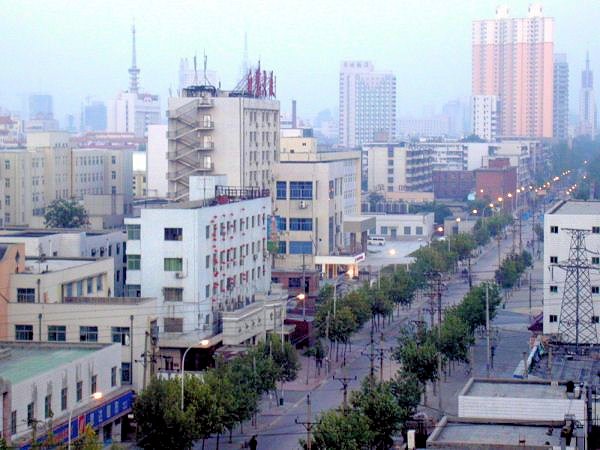
On the day of their son's surgery, the family woke before dawn. They saddled their horses and set out across the 12-mile-long carpet of sand to the nearest town, where they hoped the reputed doctor would cure their frail, feverish baby.
The neighboring town, almost as poor and isolated as their own, hosts a foreign-run emergency clinic for malnourished children. But that's not where the family headed.
The doctor they chose treats patients behind a mud wall. His operating room is the sand lot that serves as his front yard. His operating table is a plastic mat lying on the dirt. His surgical tools include a screwdriver. And his remedy for malnourished children is the removal, without antiseptic or anesthesia, of their teeth and uvula.
That day, three other children were brought to the same traditional doctor, their parents paying up to $6 for a visit, or more than a week's earnings. Not even a mile away, the UNICEF-funded clinic by contrast admitted just one child for its free service, delivered by trained medical professionals.
The 4:1 ratio that you see in this sandy courtyard on just one day in just one town is a microcosm of what is happening all over Chad, and it helps to explain why, despite an enormous, international intervention, malnutrition continues to soar to scandalous levels throughout the Sahel.
The world poured more than $1 billion into the band of countries just south of Africa's vast Sahara Desert to address hunger this year alone, according to a United Nations database. A third of that money went to Chad, where 15 percent of children are acutely malnourished, says a report by aid group Save the Children. That's among the highest rates in Africa.
There are now 32 clinics equipped with the latest technology to halt starvation, most within a few hours' walk of affected families. If a child makes it to one of these centers in time, the chance of survival is remarkably high.
Yet acute malnutrition is only getting worse in the Sahel, where every year, cemeteries fill up with the bodies of children who wasted away within walking distance of help.
In 2010, 55,000 children were treated for the most acute form of malnutrition in Chad. In 2011, it was 65,000. The expected caseload for 2012 is 127,300, according to the report published in June. Overall, in the eight countries in the Sahel, the number of admissions has doubled in just three years.
One reason is that families simply do not take advantage of the safety net created for them, and cling instead to traditions that can end up killing rather than healing their children.
"We try to tell them the consequences. That these are not good treatments. That if the child has diarrhea, he should go to the hospital," says Laurent Blague, director of child protection at Chad's Ministry of Social Welfare. "Unfortunately, this is tradition."
Eight-month-old Abdallah Lamine had been sick for a month, but it wasn't until he started vomiting that his parents made the trip to the medicine man, Haki Hassane.
The mother rode a red horse, carrying her baby's hot body in her lap. She could feel the fever consuming him even through her clothes.
The remedy the healer prescribes for malnourished children is the removal of the uvula, the tiny ball of flesh that hangs from the back of the throat, which he says "gets in the way of the food." For fever, he prescribes the removal of the child's teeth.
In baby Abdallah's case he prescribed both. He grabbed the baby by one arm, placed him on the mat and pinned him down. As the child began to shriek, he dug the unwashed screwdriver into the baby's pink gums, until four tiny teeth popped out.
The healer wiped down the holes in the child's mouth with a corner of a ratty blanket, stained with the blood of the other children he'd treated that day. Then he handed the petrified, whimpering toddler to his stone-faced mother.
Tooth extraction and the removal of the uvula is common in this part of Chad. Elsewhere, the treatment for diarrhea is burning the child's anus with a rod heated over a fire. Other treatments include draining the "bad blood," a procedure recommended when children's bodies swell, a sign of severe malnutrition.
Similar practices prevailed in Europe and America as late as the 18th century. The advances in world medicine since have made their way to Chad in the form of internationally-run clinics, but they continue to be seen as foreign. More than half of Chad's people still use traditional healers, according to a survey by the Pew Forum on Religion and Public Life in 2010, whose remedies can be effective for some ailments.
Malnutrition is not one of them. Already malnourished children who have their uvula cut can't eat for at least a week, says health official Blague. When the child does eat, the open wound often gets infected. This worsens the malnutrition.
Because the infection can last several weeks, families believe their baby has simply contracted a different ailment. Chad's government has never addressed these harmful practices. The issue remains extremely sensitive, in part because the healers claim their gift came from Allah and in part because many local officials were submitted to such practices themselves when they were children, aid workers say.
Hassane says in 30 years of practice, he's never fielded any complaints from parents whose children became sicker.
"If a child has fever or diarrhea, once he opens his mouth, I can instantly tell. If I put my finger on his gum and feel it, I can tell if it's due to his bad teeth. Once we take out this bad tooth, the diarrhea stops," Hassane says. "And if the child gets sick again, it's because he had some other illnesses in his system."
Moussa Mahamat Ali, the chief of the healers in the town of Mao, the regional capital, claims that all the children who have come to him have been cured of malnutrition.
"If the child is sick ... he has yellow hair, he doesn't eat, he's skinny, it's because of the bad teeth," says the 75-year-old Ali. "This is a treatment for malnutrition. No one has ever told me that this is bad."
By the time children do turn up at the United Nations-funded centers, they have already been through hell. Nearly every week, health workers here admit dangerously emaciated children with a foamy substance coming out of their mouths.
Malnutrition is the underlying cause for the deaths of 2.6 million children every year, according to a study published in the scientific journal, The Lancet. That's a third of the global total for children's deaths.
At the feeding center in the town of Mao, run by the French aid group Action Against Hunger, a mother has come in carrying a bundle in her arms. When she pulls back the sheet, the health workers gasp. It looks like she has brought in a skeleton.
The best predictor for the severity of malnutrition is the circumference of a child's upper arm, the World Health Organization has found over years of responding to famines in Africa. Less than 115 millimeters indicates the child is at risk of imminent death.
This child's arms measure just 80 millimeters around. She weighs 5.2 kilograms (11.4 pounds), slightly more than a healthy newborn. She is 3 years old.
It takes a moment for the health workers to realize that the little girl, Fatime, has been admitted before.
Fatime's short history is a litany of the well-meant customs that get in the way of a child's health, and possibly even her life.
She was born underweight. Women in Chad, including her mother, are discouraged from eating during pregnancy, in the hope that a small child will be easier to deliver.
Fatime's mother stopped breastfeeding her when she became pregnant with her youngest child. She was told that pregnancy tainted her milk and could poison the child still nursing.
Zara Seid, the mother, collected the bitter chaff left over when women pound millet into flour, mixed it with water and painted it on her breasts. The bitter taste repelled the toddler, and she was weaned overnight.
Yet in a place where food is hard to come by, it meant that Fatime began her precipitous fall into undernourishment.
Malnutrition and disease work in a deadly cycle, and soon Fatime got sick with diarrhea and a fever. The lack of a proper diet weakens the immune system and makes childhood diseases more severe. The sick child then loses more weight, making recovery more difficult.
More than a year ago, Fatime's mother brought her into the clinic.
Like many African women, though, her mother needed permission from her husband to leave her family and stay away. And she knew he was starting to get impatient.
Over the pleas of the health workers, she left the clinic only a week after she got there. And upon the advice of villagers, she went to the traditional healer, a one-day visit instead of a three-week hospital stay.
The medicine man diagnosed the child's illness as the result of her baby teeth. He heated a blade in the fire and pulled them out.
"I thought this would bring back my daughter's health, so I took heart from that, even if it was hard to see her in pain," says Seid. "After we took out the bad teeth, it seemed like she was getting better. ... Then she got seriously worse."
It took the death of Fatime's baby cousin from malnutrition for her father to finally give her mother the permission to make a second, 1.5-hour journey to the clinic.
By the time Fatime made it to the clinic the second time, she didn't look much bigger than a fetus. Zara Seid kept her daughter wrapped in a cloth, as if embarrassed to show her body, the frightening sight of a child on the knife's edge of starvation.
Her head is bald except for a few tufts of hair. Her mouth is infected with lesions, and stained purple with the antifungal wash the nurses use daily. When she tries to drink formula, she coughs until her tiny, doll-like chest heaves.
Her legs are insect-like, unable to hold her up. They dangle, lifeless. Her arms are no bigger than a shower rod.
Flies are attracted to her, as if she is already dead. They land on her face and crawl in and out of the corners of her eyes.
These mistakes lead here, to a set of humps in the sand. There's a burial ground in every village in this part of Chad, including in Djiguere, where Fatime's cousin lies under the newest hump of sand.
The big mounds are where the adults are buried. But the majority of the piles in the cemetery are small. Some are no larger than a loaf of bread.
Fatime may or may not make it. In the week since she arrived at the feeding center, she's gained 200 grams (7 ounces).
At home in the village, her father, Mahamat Ibrahim, says he has no regrets about having had his daughter's teeth extracted. Bad teeth are to blame for a child not growing, he says.
"This is something that everyone here knows," he says. "It's only the doctors at these foreign hospitals that don't know this. And that's why we avoid taking our children there."
His youngest child is five months old. In a few weeks, her baby teeth will start coming in.
If she falls sick, he plans to take her to the healer to yank them out.
Sunday 23 December 2012
http://www.chron.com/news/world/article/Traditions-in-Chad-harm-kill-underfed-children-4141808.php#photo-3933881
 At least six passengers -- including three of a family-- were drowned when a boat capsized mid-river in Magura on Saturday.
At least six passengers -- including three of a family-- were drowned when a boat capsized mid-river in Magura on Saturday. 








